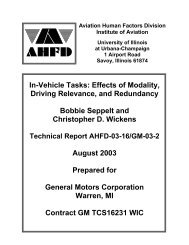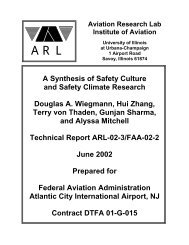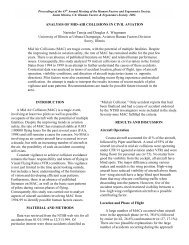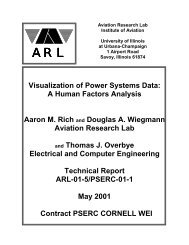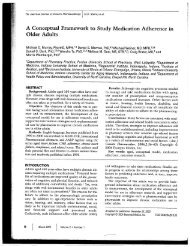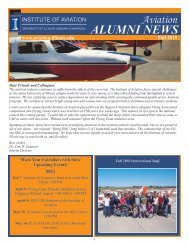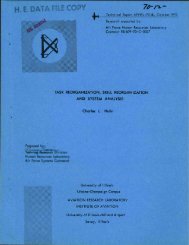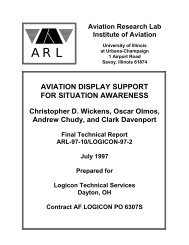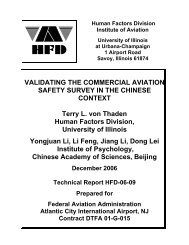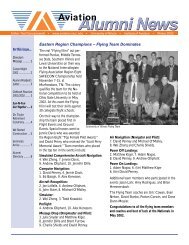Defining and Assessing Safety Culture in High Reliability Systems
Defining and Assessing Safety Culture in High Reliability Systems
Defining and Assessing Safety Culture in High Reliability Systems
You also want an ePaper? Increase the reach of your titles
YUMPU automatically turns print PDFs into web optimized ePapers that Google loves.
Isaac, R. G. (1993). Organizational culture: Some new perspectives. In R. T.<br />
Golemanbiewski (Ed.), H<strong>and</strong>book of organizational behavior (pp. 91-110). New York: M.<br />
Dekker.<br />
Several issues related to organizational culture were discussed <strong>in</strong> this chapter, which <strong>in</strong>clude the<br />
def<strong>in</strong>itions <strong>and</strong> components of organizational culture (values, beliefs, ideologies, attitudes <strong>and</strong><br />
artifacts); the genesis of cultural elements <strong>and</strong> the major mechanisms associated with culture<br />
formulation; the problems associated with culture ma<strong>in</strong>tenance (recruitment <strong>and</strong> socialization);<br />
the problems with culture transmission <strong>in</strong> socialization (unconscious awareness of organizational<br />
culture, the level of socialization, <strong>and</strong> the immutability of cultural elements); issues on culture<br />
change at organizational level (processes of culture change, tools <strong>and</strong> recipes for cultural<br />
<strong>in</strong>tervention, tim<strong>in</strong>g for <strong>in</strong>tervention, <strong>and</strong> problems associated with culture change <strong>in</strong>terventions);<br />
<strong>and</strong> issues on culture strength (def<strong>in</strong>ition of culture strength, arguments for <strong>and</strong> aga<strong>in</strong>st<br />
promot<strong>in</strong>g robust cultures, factors <strong>in</strong>fluence the strength of organizational culture, alternative<br />
model of culture strength, <strong>and</strong> levels of analysis on culture strength). Based on the discussion on<br />
the above aspects of organizational culture, current status of organizational culture research was<br />
summarized <strong>and</strong> issues need<strong>in</strong>g attention were listed.<br />
James, L. R. (1988). Organizational climate: Another look at a potentially important<br />
construct. In S. G. Cole, R. G. Demaree, & W. Curtis (Eds.), Applications of <strong>in</strong>ternationist<br />
psychology: Essays <strong>in</strong> honor of Saul B. Sells (pp. 253-282). Hillsdale, NJ: Elbaum.<br />
Organizational climate <strong>in</strong>volves the aggregation of psychological climate scores. It is suggested<br />
that the prerequisite for aggregat<strong>in</strong>g <strong>in</strong>dividual psychological climate scores should be an<br />
acceptable perceptual agreement. And the traditional criterion for perceptual agreement is a<br />
reasonably high <strong>in</strong>traclass correlation (ICC) estimate of <strong>in</strong>terrater reliability. The appropriateness<br />
of the ICC <strong>in</strong> estimat<strong>in</strong>g <strong>in</strong>terrater reliability is discussed. It is concluded that use of the ICC that<br />
relies on between-environment differences will result <strong>in</strong> an underestimate of <strong>in</strong>terrater reliability<br />
if the mean climate scores do not vary appreciably among environments <strong>and</strong> <strong>in</strong>dividuals with<strong>in</strong><br />
environments tend to agree. That is, the underestimation of <strong>in</strong>terrater reliability is expected to<br />
occur when sampl<strong>in</strong>g environments from a s<strong>in</strong>gle type of environment or similar types of<br />
<strong>in</strong>dividuals with<strong>in</strong> homogeneous environments.<br />
A new method for estimat<strong>in</strong>g <strong>in</strong>terrater reliability is overviewed as an alternative to the ICC<br />
approach. This method employs a with<strong>in</strong>-groups design <strong>in</strong> which <strong>in</strong>terrater reliability is<br />
estimated separately for each group. The <strong>in</strong>terrater reliability with<strong>in</strong> a group is viewed as a<br />
function of two variables: the observed variance among the rat<strong>in</strong>gs on a climate item X,<br />
designated S X 2 , <strong>and</strong> the expected variance among the rat<strong>in</strong>gs on climate item X <strong>in</strong> a condition of<br />
no agreement, designated σ E 2 . The <strong>in</strong>terrater reliability is def<strong>in</strong>ed as r WG = 1- (S X 2 /σ E 2 ). Us<strong>in</strong>g<br />
the same procedure, the <strong>in</strong>terrater reliability among rater composite scores can be estimated <strong>in</strong><br />
the form of means. Examples show that the <strong>in</strong>terrater reliability estimated us<strong>in</strong>g the new method<br />
is higher <strong>and</strong> more consistent with the data than ICC. F<strong>in</strong>ally, empirical comparison of betweengroups<br />
<strong>and</strong> with<strong>in</strong>-groups approaches is presented.<br />
20




